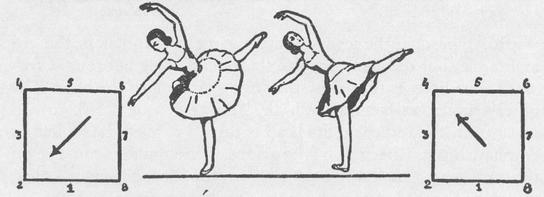Basic Principles of Classical Ballet (11 page)
Read Basic Principles of Classical Ballet Online
Authors: Agrippina Vaganova

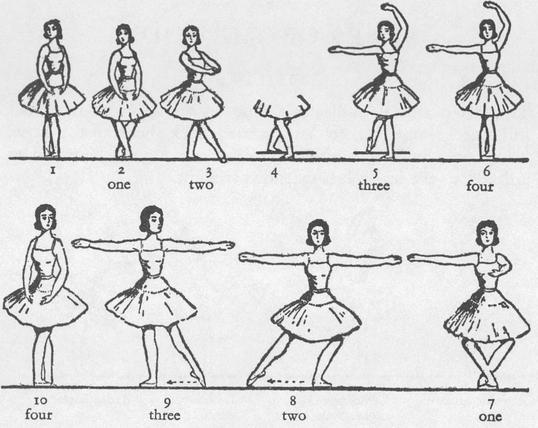
32. Temps lié
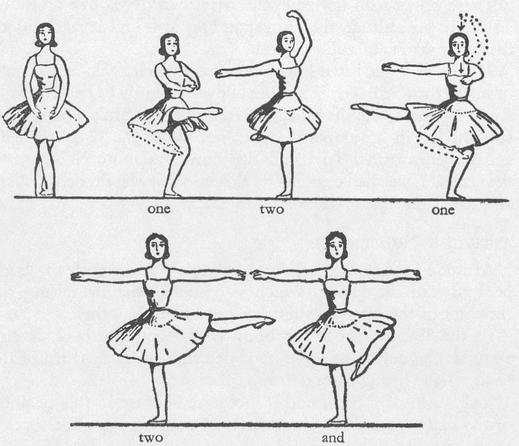
33. Temps lié (at 90°)
V
POSES OF THE BODY
ATTITUDES
THE WORD attitude indicates a pose on one leg with the other lifted at an angle of 90° and carried back, bent at the knee. Therefore a pose with a développé forward cannot be called an attitude, as the leg in it is extended straight.

34.
These poses I do not call otherwise than développé croisé or effacé. In an attitude the corresponding arm and leg are lifted, the other arm is in 2nd position.
The knee of the lifted leg must be taken well back, and should never be dropped. The bent knee allows the body to bend as well. In doing turns, the movement is free and beautiful, whereas the straight leg in an arabesque does not allow the body to bend and impedes turns. To familiarize ourselves more closely with the attitude, we shall examine its execution by the French, Italian, and Russian schools, in croisé and effacé.
ATTITUDE CROISÉE
Attitude croisée in the French school is taken with the body bent toward the leg on which you stand, thereby raising the shoulder of the lifted arm much higher than the other.
In the Italian school the body is straight, the back is also straight, the design of the pose is determined by the turn of the head, or the lifting of one or the other arm.
This form of the attitude is incorrect because in this position of the body the knee is not sufficiently supported, and it appears to be hanging. If one should want to support the knee with the upper part of the leg, with the hip, the knee will move away from the body, and the resulting pose will be ugly.
My attitude croisée is as follows:
The shoulders are even, the body bent back, the back not straight but arched, the leg bent forcefully back. The head is turned definitely toward the shoulder. The body in atittude inevitably inclines toward the standing leg, but because of the tensed leg, and well-arched back, the shoulders are evened out, achieving the desired form. The arms may be changed, you may lift the one opposite the raised leg, changing the tilt of the body without spoiling the correctness of the pose. When the spine works properly one may play with the body at will.
ATTITUDE EFFACÉE
If in attitude croisée the leg must be bent in the knee, in attitude effacée it should be only half-bent, otherwise the resulting pose will not be beautiful.
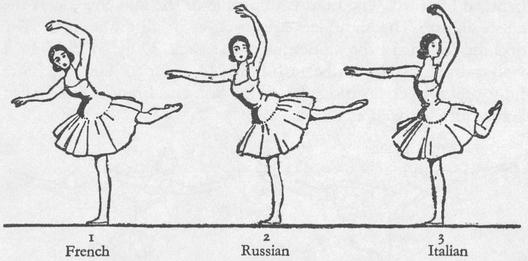
35. Attitude effacée
The Italian attitude effacée conserves the straight back, nevertheless the body is distorted by being bent toward the bent leg. When doing a pirouette in this position, the pose is lost, either the knee hangs down involuntarily, or on the contrary, the knee rises and the toe hangs down.
My attitude approaches the French one. The body is directed toward the standing foot, slightly forward; the arms and the entire pose have an inclination in one direction, which lends this attitude an impression of flight. The difference between this attitude and the French one is the same as in attitude croisée. In spite of the direction of the body toward the standing foot, one shoulder is not higher than the other.
Such an attitude is extremely convenient for turns.
ARABESQUES
The arabesque is one of the basic poses in contemporary classical ballet.
If in attitude the leg is bent or half-bent, in arabesque it must always be fully extended. The forms of the arabesque are varied to infinity. The four principal arabesques accepted in our technique are the following:
1st Arabesque: (also called open, ouverte or allongée, but at present these terms are no longer in use).
The body rests on one leg. The other, extended and straight, is lifted from the ground to an angle of no less than 90°. The feet are in position effacé. The arm opposite to the lifted leg is extended forward, the other one is taken out to the side. The hands are held palms down, as if leaning on the air. The body is inclined forward. The head is in profile to the audience, as is the entire figure. The shoulders are level, as in all arabesques. The deciding factor in the arabesque is the back. Only by holding it well can one produce a beautiful line. In order to illustrate more fully the correct position, let us analyse the French and Italian arabesques, as well as ours.
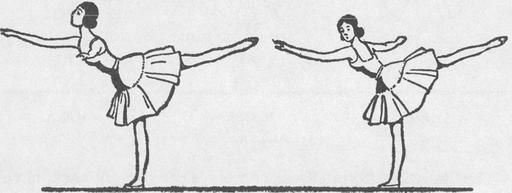
36. 1st arabesque 2nd arabesque
The French arabesque takes the pose in a slipshod way, the back is not extended forward, not tensed; it just leans passively forward. The arm is artificially held in a 2nd position, which gives it a stiff, inexpressive look.
The Italian arabesque eliminates the laziness of the pose. The body is tensed but not inclined, the back remains upright, the arm is taken further back from the 2nd position.
I indicate the following arabesque:
The body is bent forward as much as the impulse forward is felt, the back is not relaxed, but strongly arched, tensed at the waist. The arm is brought out to the side only as far as is necessary for the comfort of all the strongly stretched muscles of the entire body, i.e. just a little behind the 2nd position.
2nd Arabesque: body and legs are the same as in 1st arabesque, but now the arm corresponding to the leg is extended forward. The other arm is brought back far enough to be seen behind the body. The head is turned to the audience.
3rd Arabesque: this arabesque faces the audience. The leg is croisé back at an angle of 90°. The body is bent forward, the back tensed. The arm corresponding to the extended leg is extended, the other one is taken out to the side. The face is turned toward this hand as if watching its movement.
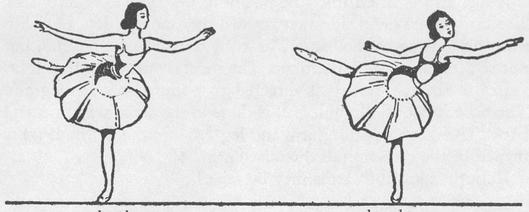
37. 3rd arabesque 4th arabesque
4th Arabesque: the legs are in the same position as in the 3rd arabesque, but the arm opposite the extended leg is brought forward. The body is turned by the strong arching of the back. The other arm shows behind the back. This arabesque is half turned away from the audience, the head is turned toward the audience, emphasising its direction by the glance. The shoulders must be on the same level. The body must not lean forward. This is the most difficult of arabesques, and requires careful study of its form.
When we begin to do turns in arabesque, we begin to understand the relative value of the different arabesques, the French, Italian and ours.
In turns, the French arabesque does not allow us to develop the movement. The Italian arabesque invariably causes the knee to bend, breaking the line, which is habitually observed with Italian dancers. The arabesque I teach gives balance, energy in turning, and at the same time the extension of the entire pose and legs is not lost.
When doing a turn in arabesque, the arabesque must be clearly expressed. From the preparation (4th position croisé) one must, having pushed off with the heel of the front foot, take a definite arabesque, otherwise the turn will not be successful, the power will be lost. Being clearly conscious of this, one must “push off” into arabesque without counting on correcting the pose during the movement.
ÉCARTÉ
The pose écarté is done as follows:
Écarté back. Standing on right foot, bring out the left leg in a développé at an angle of 90° in the direction of point 6 in our diagram. The leg is strongly turned out from the hip. The entire pose is taken in one plane, diagonally toward the audience. The left arm is lifted into 3rd position, the right one into 2nd. The body must bend sideways toward the standing leg, but with a strong tensing of the back. The body must remain natural, but not so simple as to be inartistic. The head is turned to the right.
Écarté front. The leg is directed to point 8 in our diagram. The pose is proud, dignified. It is done in the same way as écarté back. The corresponding arm and leg are lifted, and the head is turned in the direction of the raised arm.
In both cases both arms may be raised.
